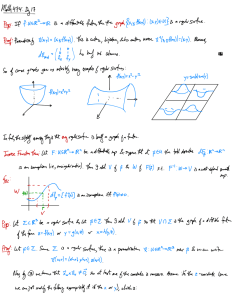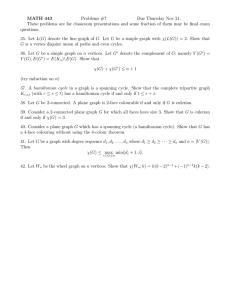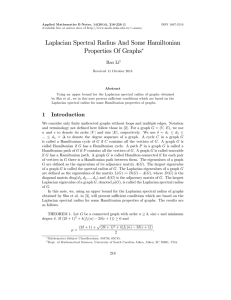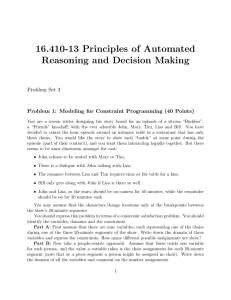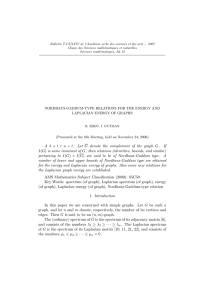On Balanced CSPs with High Treewidth ∗ {
advertisement
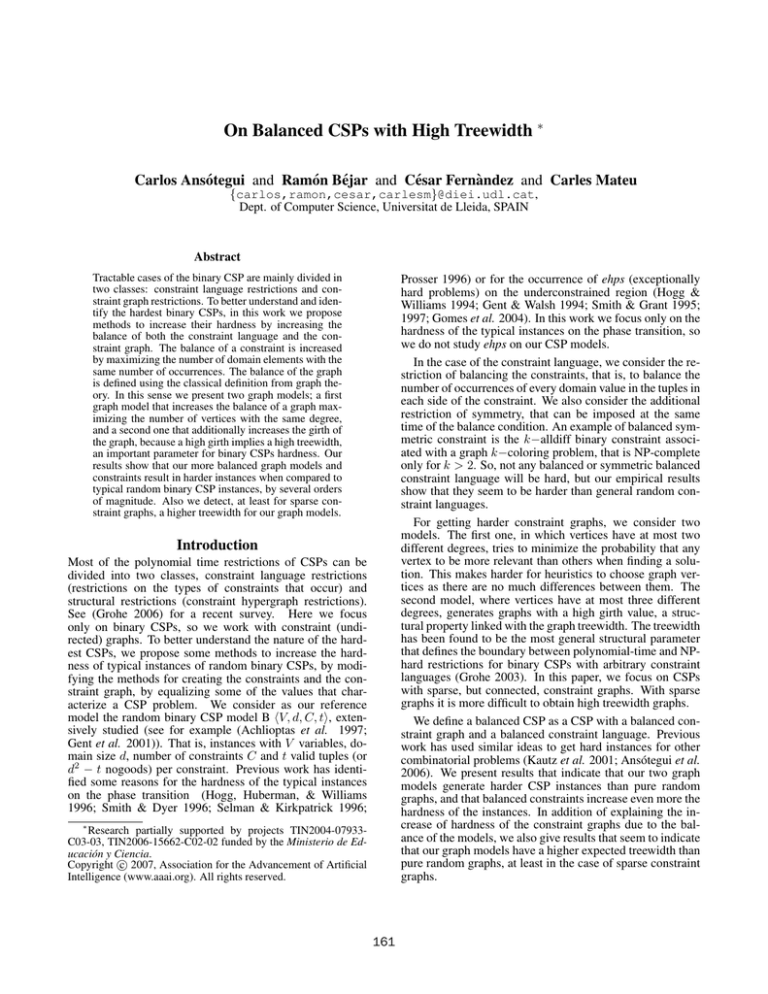
On Balanced CSPs with High Treewidth ∗
Carlos Ansótegui and Ramón Béjar and César Fernàndez and Carles Mateu
{carlos,ramon,cesar,carlesm}@diei.udl.cat,
Dept. of Computer Science, Universitat de Lleida, SPAIN
Abstract
Tractable cases of the binary CSP are mainly divided in
two classes: constraint language restrictions and constraint graph restrictions. To better understand and identify the hardest binary CSPs, in this work we propose
methods to increase their hardness by increasing the
balance of both the constraint language and the constraint graph. The balance of a constraint is increased
by maximizing the number of domain elements with the
same number of occurrences. The balance of the graph
is defined using the classical definition from graph theory. In this sense we present two graph models; a first
graph model that increases the balance of a graph maximizing the number of vertices with the same degree,
and a second one that additionally increases the girth of
the graph, because a high girth implies a high treewidth,
an important parameter for binary CSPs hardness. Our
results show that our more balanced graph models and
constraints result in harder instances when compared to
typical random binary CSP instances, by several orders
of magnitude. Also we detect, at least for sparse constraint graphs, a higher treewidth for our graph models.
Prosser 1996) or for the occurrence of ehps (exceptionally
hard problems) on the underconstrained region (Hogg &
Williams 1994; Gent & Walsh 1994; Smith & Grant 1995;
1997; Gomes et al. 2004). In this work we focus only on the
hardness of the typical instances on the phase transition, so
we do not study ehps on our CSP models.
In the case of the constraint language, we consider the restriction of balancing the constraints, that is, to balance the
number of occurrences of every domain value in the tuples in
each side of the constraint. We also consider the additional
restriction of symmetry, that can be imposed at the same
time of the balance condition. An example of balanced symmetric constraint is the k−alldiff binary constraint associated with a graph k−coloring problem, that is NP-complete
only for k > 2. So, not any balanced or symmetric balanced
constraint language will be hard, but our empirical results
show that they seem to be harder than general random constraint languages.
For getting harder constraint graphs, we consider two
models. The first one, in which vertices have at most two
different degrees, tries to minimize the probability that any
vertex to be more relevant than others when finding a solution. This makes harder for heuristics to choose graph vertices as there are no much differences between them. The
second model, where vertices have at most three different
degrees, generates graphs with a high girth value, a structural property linked with the graph treewidth. The treewidth
has been found to be the most general structural parameter
that defines the boundary between polynomial-time and NPhard restrictions for binary CSPs with arbitrary constraint
languages (Grohe 2003). In this paper, we focus on CSPs
with sparse, but connected, constraint graphs. With sparse
graphs it is more difficult to obtain high treewidth graphs.
We define a balanced CSP as a CSP with a balanced constraint graph and a balanced constraint language. Previous
work has used similar ideas to get hard instances for other
combinatorial problems (Kautz et al. 2001; Ansótegui et al.
2006). We present results that indicate that our two graph
models generate harder CSP instances than pure random
graphs, and that balanced constraints increase even more the
hardness of the instances. In addition of explaining the increase of hardness of the constraint graphs due to the balance of the models, we also give results that seem to indicate
that our graph models have a higher expected treewidth than
pure random graphs, at least in the case of sparse constraint
graphs.
Introduction
Most of the polynomial time restrictions of CSPs can be
divided into two classes, constraint language restrictions
(restrictions on the types of constraints that occur) and
structural restrictions (constraint hypergraph restrictions).
See (Grohe 2006) for a recent survey. Here we focus
only on binary CSPs, so we work with constraint (undirected) graphs. To better understand the nature of the hardest CSPs, we propose some methods to increase the hardness of typical instances of random binary CSPs, by modifying the methods for creating the constraints and the constraint graph, by equalizing some of the values that characterize a CSP problem. We consider as our reference
model the random binary CSP model B V, d, C, t, extensively studied (see for example (Achlioptas et al. 1997;
Gent et al. 2001)). That is, instances with V variables, domain size d, number of constraints C and t valid tuples (or
d2 − t nogoods) per constraint. Previous work has identified some reasons for the hardness of the typical instances
on the phase transition (Hogg, Huberman, & Williams
1996; Smith & Dyer 1996; Selman & Kirkpatrick 1996;
∗
Research partially supported by projects TIN2004-07933C03-03, TIN2006-15662-C02-02 funded by the Ministerio de Educación y Ciencia.
c 2007, Association for the Advancement of Artificial
Copyright Intelligence (www.aaai.org). All rights reserved.
161
Balancing the constraint language
An interesting question related to balanced, symmetric or
not symmetric, constraints is which additional conditions
ensure the CSP is NP-complete. For example, the symmetric balanced k−alldiff constraint associated with the binary
CSP encoding of a graph k−coloring problem, is an NPhard case, but only if k > 2.
Balanced constraints
The first way to increase the hardness is to balance the number of occurrences of every domain value on each side of
the constraint. A constraint Ri,j with the same number of
occurrences of every domain value on each side of the constraint can be seen as a regular bipartite graph (Vi ∪ Vj , E),
where part Vi of the graph is associated with side i of the
constraint, having an edge {a, b} in E, with a ∈ Vi and
b ∈ Vj , iff (a, b) ∈ Ri,j . That is, the set of allowed tuples
(a, b) of the constraint is determined by the set of edges of
the regular bipartite graph.
In order to sample from the set of regular bipartite graphs
we use a Markov chain algorithm that walks between regular
bipartite graphs (Kannan, Tetali, & Vempala 1997). Observe
that a perfectly balanced constraint with t tuples must satisfy
that t/d is an integer, otherwise we can have an almost balanced constraint. That is, a constraint where d − (t mod d)
domain values appear t/d times in each side of the constraint and (t mod d) domain values appear t/d + 1 times
in each side of the constraint. This more general constraint
is associated with a bi-regular bipartite graph (vertices can
have either degree t/d or t/d + 1), that can be generated
with the Markov chain algorithm as well.
Balancing the constraint graph
Pure random graphs
As far as we know, in typical random distributions of CSPs,
the constraint graph has been built following either the
G(V, p) or the G(V, M ) random graph model. We consider
here the model G(V, M ), because we are interested in comparing the hardness of this model with others in which also
the number of edges is an exact input parameter, and not an
expected value as in the G(V, p) model3 .
Random regular graphs
As the first model for a harder constraint graph we propose
regular graphs, i.e. graphs where all the vertices have the
same degree. The most obvious reason why these graphs
can be harder is that since all the degrees are equal, degreebased search heuristics will be less effective. A less trivial
reason can be the following. A graph G = (V, E) is perfectly balanced iff for any subgraph (V , E ) of G:
Symmetric balanced constraints
|E|
|E |
≥ |V |
|V |
Here we consider an additional restriction over the constraints. In addition to being balanced, we also impose the
constraints to be symmetric ((a, b) ∈ Ri,j ⇔ (b, a) ∈ Ri,j )
and not to include any tuple of the form (a, a), for any value
a of the domain. In this case, a constraint can be associated with a regular (undirected) graph (V, E), where the
vertices are the domain values, and {a, b} ∈ E ⇔ (a, b) ∈
Ri,j ∧ (b, a) ∈ Ri,j . It is interesting to consider this additional restriction because it was shown in (Hell & Nešetřil
1990) that a constraint language having only one symmetric constraint (but not necessarily balanced) is NP-hard only
when the associated graph is non-bipartite and does not contain loops1 . Because asymptotically a random graph will not
be bi-partite, it is interesting to check empirically whether
the additional restriction of symmetric language creates typical instances of equivalent hardness to the previous model,
or the frequency of hard instances decreases.
Analogously to the previous model, we need to consider
bi-regular graphs, because depending on the number of tuples t not all values can appear the same number of times 2 .
To generate the bi-regular graph associated with a symmetric
balanced constraint, we use a generalization of the algorithm
presented in (Steger & Wormald 1999). In principle, that algorithm is presented only for regular graphs, but it can be
easily generalized for the case of graphs with vertices with
two different degrees k and k + 1. Since the two degrees
are contiguous the performance of the generalization of the
algorithm seems to be almost identical to the regular case,
although in this case we cannot guarantee a perfect uniform
distribution of graphs.
That is, the average degree (or edge density), of any subgraph is never greater than in the whole graph G. We consider a graph more balanced than other if the number of its
subgraphs that satisfy that relation is higher. For graphs
where some vertices have a higher degree than others, as
in G(V, p) or G(V, M ), one may find subgraphs with bigger edge density than the whole graph. However, any connected regular graph is perfectly balanced. Balanced graphs
will tend to be harder for heuristics, because it will be less
easy to isolate potentially overconstrained subproblems during the search, as the edge density of any subproblem will
be never higher. Of course, the fact of finding potentially
overconstrained subproblems will also depend on the particular constraints between the variables of the subproblem.
This is why in this work we have also considered balancing
the constraints. Because we want to consider graphs with
any desired number of edges, we use the same more general model of bi-regular graphs (and regular graphs when
E ∗ 2/V is an integer) that we use for building a symmetric balanced constraint. Not every bi-regular graph will be
perfectly balanced, but in general they will be much more
balanced than sparse pure random graphs.
As we have said in the introduction, the treewidth of
a graph is the most relevant structural parameter concerning the complexity of binary CSPs with arbitrary constraint
languages (Grohe 2003). A tree-decomposition of a graph
G = (V, E) (Roberston & Seymour 1986) is a pair (T, β),
where T is a tree (V T , E T ) and β : V T → 2V such that:
1
1. For every v ∈ V the set {t ∈ V T |v ∈ β(t)} is non-empty
and connected in T .
Observe that using a bi-partite graph for building a symmetric
constraint is not equivalent to what we do in the previous model,
because there the bipartite graph is used in a different way.
2
Also, if t is odd there will be a tuple (a, b) ∈ Ri,j s.t. (b, a) ∈
Ri,j (Ri,j will be almost symmetric).
3
For G(V, p) the expected number of edges is pV (V − 1)/2
but in G(V, M ) the number of edges is always M .
162
that only when pV >> log2 V , the expected spectral gap
tends to be high (although the results do not clarify if as
high as with regular graphs). For pV = O(log V ) (when
we have the sparsest but still connected random graphs) the
results only indicate that the graph will contain a large subgraph with large spectral gap. Moreover, most of the existing constructions of good expander graphs (or even Ramanujan graphs) consist of regular graphs of constant degree (See chapter 6 of (Chung 1997) for some examples).
By contrast, the results of (Coja-Oghlan 2007) indicate that
random graphs G(V, p) with expected constant degree have
a spectral gap of o(1), so they are neither expander graphs
nor have a high treewidth spectral lower bound. Therefore,
theoretical results show a clear difference between random
graphs and random regular graphs when considering graphs
with expected constant degree, but such a difference is less
obvious as we increase the expected degree.
2. For every e ∈ E there is a t ∈ V T s.t. e ⊆ β(t).
The width of the tree-decomposition is max{|β(t)| |t ∈
V T } − 1 and the treewidth of G (tw(G)) is the minimum width among all tree-decompositions. Concerning the
treewidth of random regular graphs, we can use the following lower bound, that is also valid for general graphs,
based on the spectrum of the (combinatorial) Laplacian of
the graph (Chandran & Subramanian 2003):
3V
μ
tw(G) ≥
−1
4
Δ + 2μ
Where Δ is the maximum degree of G, the Laplacian of G is
the matrix D − A, where D is the diagonal matrix in which
Di,i is the degree of vi , A is the adjacency matrix of G and
μ is the second smallest eigenvalue of the Laplacian.
For the case of a k−regular graph, where μ = k − λ2 (G),
this lower bound can be rewritten as:
3V
k − λ2 (G)
−1
tw(G) ≥
4
3k − 2λ2 (G)
High girth graphs
Another way to generate graphs with high treewidth is to
consider graphs with high expected girth. The girth of a
graph is the length of its shortest cycle. In (Chandran &
Subramanian 2005) it is shown that if the girth is at least g
and the average degree at least d, then we have:
1
tw(G) = Ω
(d − 1)(g−1)/2
g+1
For random k−regular graphs it is known that the average
girth is only slightly greater than 3 (McKay, Wormald, &
Wysocka 2004).
In (Chandran 2003), the authors present an algorithm that,
for given V and k (with k < V /3), it builds a graph with
girth g that satisfies:
g ≥ logk (V ) + O(1)
Where the vertices of the graph have one of these possible
degrees: k − 1, k or k + 1. So, the graph is almost regular
but may be less balanced than bi-regular graphs. With such
a bound on the girth, we have that these graphs satisfy:
√
(k − 1)(logk (V )/2
V
tw(G) ≥ Ω
=Ω
logk (V ) + 1
logk (V ) + 1
Where λ2 (G) is the second largest eigenvalue of the adjacency matrix of G (k is the largest eigenvalue for a
k−regular graph). So, the higher the value of μ = k −
λ2 (G), also called the spectral gap, the closer the lower
bound gets to V /4. This shows a connection between expander graphs and graphs with a high value for this treewidth
lower bound, because this spectral gap also gives a lower
bound on the edge expansion of a graph. Roughly speaking,
an expander graph is a graph that, for any, not too big, subset
of vertices S, its set of neighbors outside S is big, compared
with |S|. See for example (Sarnak 2004) for formal definitions.
For random k−regular graphs, with k fixed, it is
known that asymptotically
√ (as V → ∞) for > 0
P robability(λ
(G)
≤
2
k − 1+) → 1 (Friedman 2004),
2
√
value
where 2 k − 1 is, asymptotically, the lowest possible
√
for λ2 (G). Regular graphs with λ2 (G) ≤ 2 k − 1 are
called Ramanujan graphs. For Ramanujan graphs, we have:
√
k−2 k−1
3V
√
tw(G) ≥
−1
4
3k − 4 k − 1
So, we can build graphs, for any value of V and k < V /3,
and even with k growing with V , such that every graph will
satisfy that lower bound. Actually, the graphs obtained with
this algorithm could have an even higher treewidth4 , because there are graphs with low girth that, however, have
a high treewidth, i.e. the complete graph KV has girth 3 and
treewidth V − 1.
The algorithm for the generation of such graphs basically
proceeds in a greedy fashion, starting with an initially empty
graph and adding edges one by one, connecting vertices
which are at large distances in the current graph. Here, we
use their algorithm with a slight modification. The original
algorithm works with k integer, giving a number of edges
V k/2. So, we cannot use it directly to get graphs with any
desired number of edges. However, one can generalize the
algorithm to proceed by adding as many edges as desired, instead of stopping when |E| = V k/2. Observe that adding
more edges will not reduce the treewidth although this can
produce a reduction of the girth of the graph.
So, for a fixed and sufficiently high k the lower bound will
get very close to V /4. As we are considering regular (or biregular) graphs with the degrees growing with V , we cannot infer directly that asymptotically
our graphs will have
√
a spectral gap of order k − 2 k − 1. Actually, as the degree grows with V , the expanding properties of the graphs
can be better for higher degrees. For example, some existing constructions of Ramanujan graphs based
√ on certain
Cayley graphs are obtained with a degree Ω( V ), whereas
similar Cayley graphs with degree O(log V ) are also expander graphs but not as good as Ramanujan graphs (Alon
& Roichman 1994). As far as we know the best result for
non-constant degree random k−regular graphs is, if k >
√
V log V then asymptotically λ2 (G) = o(k) (Krivelevich
et al. 2001). So those regular graphs have a high spectral
gap, and a high treewidth spectral lower bound.
For the random graph model G(V, p), recent results (Fan Chung & Vu 2004; Coja-Oghlan 2007) indicate
4
163
Our empirical results seem to confirm a higher treewidth.
V80, D20, C253, MAC dom/deg
Median time (seconds)
1000
100
100
10
10
1
V80, D20, C253, FCCBJ dom/deg
1000
1
Symmetric Bal.
Balanced
Random
0.1
Symmetric Bal.
Balanced
Random
0.1
220
230
240
250
260
220
230
Number of nogoods
240
250
260
Number of nogoods
Figure 1: Random constraints versus balanced and symmetric balanced constraints. On top, V stands for number of variables,
D for domain size and C for number of constraints.
Empirical results
Bounds on the treewidth
Calculating the treewidth of a graph is NP-hard, and even
to approximate it to within a constant absolute additive error (Bodlaender et al. 1995), so we cannot get exact results within reasonable time limits. Table 1 shows two different lower bounds and one upper bound on the treewidth
of typical instances from the three graph models considered in this paper. The values represent the median of 51
graphs obtained from each model. The first lower bound
(Heu LB) is the heuristic lower bound minimum maximum
degree (mmd+) with least-c neighbor selection strategy, as
in (Bodlaender, Koster, & Wolle 2004). The second lower
bound (Spec LB) is the spectral lower bound explained before. The upper bound (UB) shows the best heuristic upper bound obtained with either Lexicographic Breadth First
Search, variant Minimal (LEX M) used in (Koster, Bodlaender, & van Hoesel 2001) or with the min-fill heuristic (Bodlaender 2005)5 .
We observe that as the size increases the spectral lower
bound becomes much higher for our more balanced graph
models than for pure random graphs. For pure random
graphs the heuristic lower bound is the best, but never better
than the spectral lower bound for our graph models. So, our
graph models seem to have a high spectral gap, and thus a
high treewidth lower bound. For the upper bound, we clearly
observe that higher values are obtained for our models and
that the difference increases with the size. To conclude, even
if the gap between the lower and upper bounds is too big to
infer exact results about the treewidth, they seem to indicate
higher values of the treewidth for our graph models.
All the plots contained in this section are obtained using
Forward-Checking with Conflict Back-Jumping (FCCBJ)
and Maintaining Arc-Consistency (MAC) search algorithms
with variable selection heuristic dom/deg (Prosser 1993;
Bessière & Régin 1996). Note that other algorithms and
heuristics have also been used, for different sizes and constrainedness, showing similar qualitative behavior. More
specifically, the same set of problems have been solved with
previous mentioned algorithms with dom+deg and dom/deg
heuristics, as well as with Forward Checking (Haralick &
Elliott 1980) and a MAC solver using a Satz-like heuristic
as described in (Ansótegui et al. 2004).
Balanced constraints
Figure 1 shows the hardness of solving CSPs with either
random constraints, balanced constraints or symmetric balanced constraints for sparse constraint graphs (|edges| =
(V /2) log2 V ) using MAC and FCCBJ. Differences between
random and balanced constraints almost achieve an order
of magnitude, meanwhile differences between balanced and
symmetric balanced are irrelevant.
Balanced graphs
Figure 2 shows the hardness of solving CSPs with either
pure random, bi-regular or high girth constraint graphs for
random constraints. Clearly, our graph models give typical instances of higher complexity than pure random graphs.
Between pure random and bi-regular graphs the difference
is of several orders of magnitude, and less than 1 order between bi-regular and high girth graphs.
Right plot on Figure 2 shows the hardness for a larger
problem solved with the best performing algorithm (MAC).
As noted, differences between pure random and our graph
models increase with the problem size.
Combined effect
Figure 3 shows the hardness of solving pure random CSPs,
CSPs with bi-regular constraint graphs and balanced con5
We thank Arie Koster for providing us with the implementations of the treewidth algorithms and the referees for suggesting to
use the min-fill heuristic.
164
Median time (seconds)
10
V100, D8, C333, FCCBJ & MAC dom/deg
4
10
High Girth (FCCBJ)
Bi-regular (FCCBJ)
High Girth (MAC)
Bi-regular (MAC)
Random (FCCBJ)
Random (MAC)
1000
100
V115, D9, C393, MAC dom/deg
4
High Girth
Bi-regular
Random
1000
100
10
10
1
1
0.1
0.1
24
26
28
30
32
34
36
34
36
38
Number of nogoods
40
42
44
Number of nogoods
Figure 2: Random graphs versus bi-regular and high girth graphs.
V
100
200
300
400
500
600
Heu LB
G(V, M )
Spec LB
UB
Heu LB
bi-regular
Spec LB
UB
Heu LB
high girth
Spec LB
UB
15
22
28
33
38
42
3
6
14
12
22
28
36
80
127
175
224
274
15
22
28
33
38
42
13
28
43
61
79
92
44
96
153
206
263
323
15
23
29
34
39
43
14
30
45
63
81
94
46
98
154
209
265
324
Table 1: Comparison of lower and upper bounds on the treewidth for the different graphs, with |edges| = (V /2) log2 V
Median time (seconds)
10
V70, D10, C215, FCCBJ & MAC dom/deg
4
High Girth Bal. (FCCBJ)
Bi-regular Bal. (FCCBJ)
High Girth Bal. (MAC)
Bi-regular Bal. (MAC)
Random (FCCBJ)
Random (MAC)
1000
100
10
5
10
4
V80, D12, C253, MAC dom/deg
High Girth Bal.
Bi-regular Bal.
Random
1000
100
10
10
1
1
0.1
0.1
45
50
55
60
65
70
70
75
Number of nogoods
80
Number of nogoods
Figure 3: Random CSPs versus balanced CSPs
165
85
90
straints and CSPs with high girth constraint graphs and balanced constraints. This time, the differences between the
models are even higher than before: more than 3 orders of
magnitude for the best algorithm (MAC) and 4 orders for
FCCBJ. The right plot shows that the differences for the best
algorithm increase with a larger problem.
So, we observe that the increase in hardness is much more
significant when we balance both; the constraint graph and
the constraints, and that although the high girth graphs give
the hardest instances, more dramatic differences arise between random and bi-regular graphs than between bi-regular
and high girth graphs. Our high girth graphs seem to have
the highest treewidth, although the bounds are very similar with bi-regular graphs. Also, probably they are not
as balanced as bi-regular graphs, although it is not clear
that having three contiguous degrees, instead of just two,
makes a significant difference on the balance of the graphs.
This may partially explain the lower difference between biregular and high girth graphs than between bi-regular and
random graphs. Probably, high girth graphs as balanced as
bi-regular graphs could give an even higher hardness.
Chung, F. 1997. Spectral Graph Theory. Number 92 in Regional
Conference Series in Mathematics. AMS.
Coja-Oghlan, A. 2007. On the Laplacian eigenvalues of Gn,p .
Combinatorics, Probability and Computing. (to appear).
Fan Chung, L. L., and Vu, V. 2004. The spectra of random graphs
with given expected degrees. Internet Mathematics 1(3):257–275.
Friedman, J. 2004. A proof of Alon’s second eigenvalue conjecture and related problems. Memoirs of the A.M.S.
Gent, I., and Walsh, T. 1994. Easy Problems are Sometimes Hard.
AI Journal 70:335–345.
Gent, I.; MacIntyre, E.; Prosser, P.; Smith, B.; and Walsh, T.
2001. Random constraint satisfaction: flaws and structure. Constraints 6(4):345–372.
Gomes, C.; Fernández, C.; Selman, B.; and Bessière, C. 2004.
Statistical regimes across constrainedness regions. In CP’04.
Grohe, M. 2003. The complexity of homomorphism and constraint satisfaction problems seen from the other side. In Proc. of
FOCS’03, 552–561.
Grohe, M. 2006. The structure of tractable constraint satisfaction
problems. In Proceedings. MFCS’06.
Haralick, R., and Elliott, G. 1980. Increasing tree search efficiency for constraint satisfaction problems. AI Journal 14:263–
313.
Hell, P., and Nešetřil, J. 1990. On the complexity of H-coloring.
Journal of Combinatorial Theory, Series B 48:92–110.
Hogg, T., and Williams, C. 1994. The Hardest Constraint Problems: a Double Phase Transition. AI Journal 69:359–377.
Hogg, T.; Huberman, B.; and Williams, C. 1996. Phase Transitions and Search Problems. Artificial Intelligence 81 (1-2):1–15.
Kannan, R.; Tetali, P.; and Vempala, S. 1997. Simple Markovchain algorithms for generating bipartite graphs and tournaments.
In Proc. of the eighth annual ACM-SIAM Symposium on Discrete
Algorithms, 193–200.
Kautz, H.; Ruan, Y.; Achlioptas, D.; Gomes, C.; Bart; ; and
Stickel, M. 2001. Balance and filtering in structured satisfiable
problems. In Proc. of IJCAI-01, 193–200.
Koster, A. M. C. A.; Bodlaender, H. L.; and van Hoesel, C. P. M.
2001. Treewidth: Computational experiments. Electronic Notes
in Discrete Mathematics 8:54–57.
Krivelevich, M.; Sudakov, B.; Vu, V. H.; and Wormald, N. 2001.
Random regular graphs of high degree. Random Structures and
Algorithms 18:346–363.
McKay, B. D.; Wormald, N. C.; and Wysocka, B. 2004. Short
cycles in random regular graphs. Elect. J. Combinatorics 11:R66.
Prosser, P. 1993. Domain filtering can degrade intelligent backtracking search. In Proceedings IJCAI’93, 262–267.
Prosser, P. 1996. An empirical study of phase transitions in binary
constraint satisfaction problems. AI Journal 81:81–109.
Roberston, N., and Seymour, P. 1986. Graph minors ii: Algorithmic aspects of treewidth. Journal of Algorithms 7:309–322.
Sarnak, P. 2004. What is an expander ? Notices of the AMS 51(7).
Selman, B., and Kirkpatrick, S. 1996. Critical behaviour in the
computational cost of satisfiability testing. AI Journal 81:273–
295.
Smith, B., and Dyer, M. 1996. Locating the Phase Transition in
Binary Constraint Satisfaction Problems. AI Journal 81:155–181.
Smith, B., and Grant, S. 1995. Sparse Constraint Graphs and
Exceptionally Hard Problems. In Proc. IJCAI’95, 646–651.
Smith, B., and Grant, S. 1997. Modelling Exceptionally Hard
Constraint Satisfaction Problems. In Proc. CP’97, 182–195.
Steger, A., and Wormald, N. C. 1999. Generating random regular
graphs quickly. Probability and Computing 8:337–396.
Conclusions
We have defined new random binary CSP models that increase the hardness of the typical instances on the phase
transition by increasing the balance on both; the constraint
graph and the constraints between the variables. Moreover,
our results indicate that another possible explanation for the
increased hardness is that our constraint graphs seem to have
a higher threewidth than pure random graphs, at least for the
sparse constraint graphs we have used.
References
Achlioptas, D.; Kirousis, L.; Kranakis, E.; Krizanc, D.; Molloy,
M.; and Stamatiou, Y. 1997. Random Constraint Satisfaction: a
More Accurate Picture. In Proceedings CP’97, 107–120.
Alon, N., and Roichman, Y. 1994. Random Cayley graphs and
expanders. Random Structures and Algorithms 5:271–284.
Ansótegui, C.; del Val, A.; Dotú, I.; Fernández, C.; and Manyà, F.
2004. Modelling choices in quasigroup completion: Sat vs csp.
In Proc. of AAAI-04.
Ansótegui, C.; Béjar, R.; Fernández, C.; Gomes, C.; and Mateu,
C. 2006. The impact of balance in a highly structured problem
domain. In Proc. of AAAI06, 438–443. AAAI Press.
Bessière, C., and Régin, J.-C. 1996. Mac and combined heuristics: Two reasons to forsake fc (and cbj?) on hard problems. In
CP’96, 61–75.
Bodlaender, H. L.; Gilbert, J. R.; Hafsteinsson, H.; and Kloks, T.
1995. Approximating treewidth, pathwidth, frontsize, and shortest elimination tree. Journal of Algorithms 18-2:238–255.
Bodlaender, H. L.; Koster, A. M.; and Wolle, T. 2004. Contraction and Treewidth Lower Bounds. Utrecht University, technical
report UU-CS-2004-034.
Bodlaender, H. L. 2005. Discovering treewidth. In Proc. of
SOFSEM 2005 (LNCS 3381), 1–16.
Chandran, L. S., and Subramanian, C. 2003. A spectral lower
bound for the treewidth of a graph and its consequences. Information Processing Letters 87(4):195–200.
Chandran, L. S., and Subramanian, C. 2005. Girth and treewidth.
Journal of Combinatorial Theory, Series B 93:23–32.
Chandran, L. S. 2003. A high girth graph construction. SIAM
journal on Discrete Mathematics 16(3):366–370.
166
